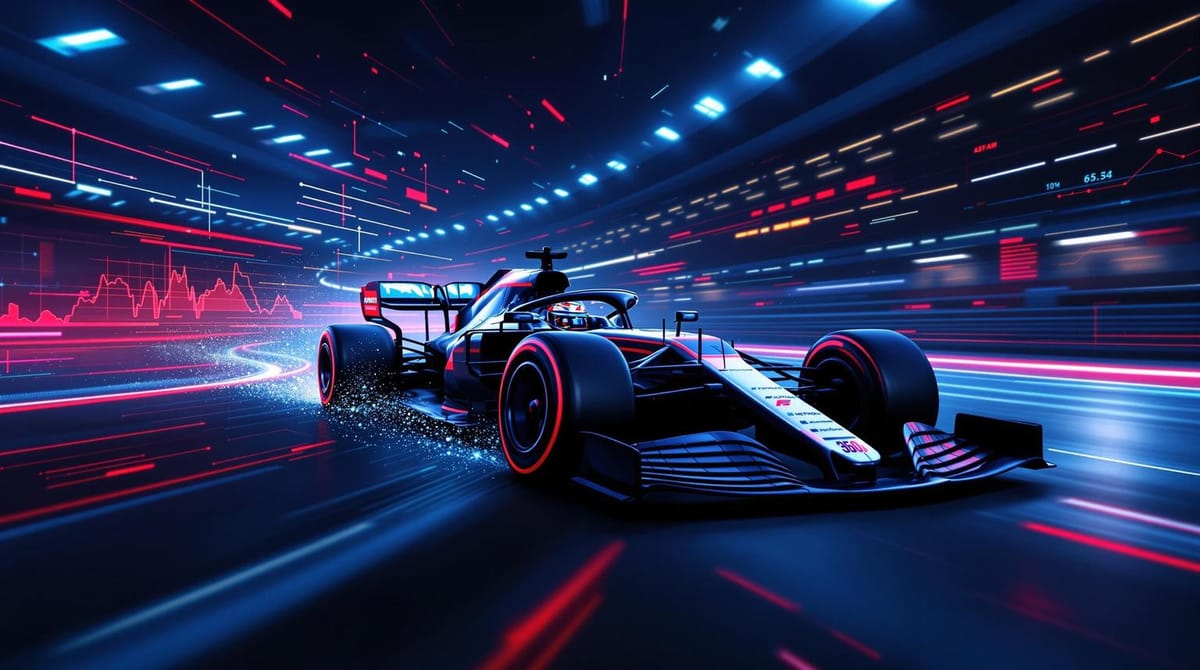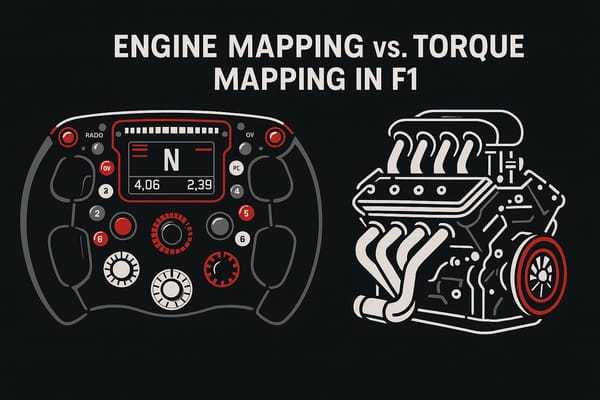How F1 Teams Use Telemetry for Energy Efficiency
Explore how F1 teams leverage telemetry to enhance energy efficiency, optimize performance, and drive innovations in racing and automotive technology.

Formula 1 telemetry has revolutionized energy efficiency in racing, combining cutting-edge data systems with real-time strategy. Here's what you need to know:
- What is telemetry? It’s the wireless transfer of real-time car data (e.g., fuel levels, tire pressure, engine temperature) to engineers for analysis and optimization. F1 cars generate over 1.5 terabytes of data per race weekend through 300+ sensors.
- Why energy efficiency matters: F1 teams must optimize performance while adhering to strict fuel limits (110 kg per race) and preparing for 100% sustainable fuel by 2026. Telemetry helps manage fuel, hybrid systems, and energy recovery.
- How telemetry works: Advanced sensors collect data, which is transmitted at speeds of 10 megabytes per second. AI and machine learning analyze this data to predict scenarios, optimize strategies, and prevent failures.
- Impact beyond racing: F1 telemetry innovations influence road cars, improving hybrid systems, fuel efficiency, and sustainability efforts.
Telemetry ensures every drop of fuel and watt of energy is used efficiently, driving both performance and sustainability in F1 and beyond.
Former F1 Data Engineer Explains Race Telemetry | MoTeC [#TECHTALK]

Main Parts of F1 Telemetry Systems
Modern F1 telemetry systems are intricate networks of hardware and software working in harmony to fine-tune energy management. Every component plays a vital role in gathering, transmitting, and analyzing the immense volumes of data that help teams make split-second decisions - decisions that can determine the outcome of a race. Let’s break down the key parts of these systems and how they contribute to energy optimization.
Sensors and Data Collection Tools
F1 cars are equipped with a vast array of sensors designed specifically for energy management. These sensors are grouped into three primary categories: control, instrumentation, and monitoring. Together, they serve as the backbone of energy efficiency tracking, capturing precise data on everything from engine temperatures to the state of the hybrid battery.
Control sensors focus on critical systems like the Energy Recovery System (ERS) and hybrid battery performance. Instrumentation sensors measure things like fuel flow, which is capped at 100 kg/h under current regulations. Meanwhile, monitoring sensors track wear and thermal conditions of components, ensuring the car operates efficiently throughout the race.
"There are over 250 sensors on the car during an average race weekend, and these can be divided into three main categories: control, instrumentation, and monitoring. All of this delivers pressure temperature, inertial, and displacement data."
– Christine Steven, Mercedes' Lead Electronics Development Engineer
The sheer volume of data generated is staggering. For instance, vibration data alone can be captured at rates of up to 200 kilo-samples per second, while other sensors operate at frequencies between 1 Hertz and 1 kilohertz, depending on their purpose. This high-frequency monitoring allows for immediate corrections to energy inefficiencies. During the 2022 Mexico GP, Mercedes collected an astounding 11 terabytes of data over the weekend.
"We generate data from a variety of sources. Primarily it's from sensors on the car itself...right through to things like the operation of the system like the internal state of all sorts of things on the car, like the gearbox."
– Evan Short, Team Leader of Trackside Electronics Systems at Mercedes F1
Data Transmission and Analysis
Once the sensors collect data, it’s transmitted wirelessly to the pit wall for real-time analysis. F1 telemetry systems use frequencies in the 1.45–1.65 GHz range, ensuring steady communication even when cars are flying down the track at over 200 mph. Each lap generates approximately 30 megabytes of live data, which is encrypted to prevent rival teams from intercepting sensitive information.
After transmission, specialized software immediately processes the incoming data. This allows teams to keep tabs on fuel consumption, refine ERS usage strategies, and address potential energy inefficiencies before they become costly. Over the course of a race weekend, a single car can generate more than 1 terabyte of data, including video footage. Advanced AI systems now play a pivotal role in interpreting this data, helping teams fine-tune their energy strategies in real time.
AI and Machine Learning in F1 Telemetry
With mountains of data pouring in, AI and machine learning step in to turn raw numbers into actionable insights. These technologies analyze billions of data points collected each season, uncovering patterns and predicting scenarios that might escape human analysts. For example, machine learning systems can forecast tire degradation, fuel usage, and the best moments to pit. This predictive power is a game-changer for energy management, enabling teams to optimize ERS deployment and adjust fuel strategies on the fly as track conditions evolve.
The speed of AI-driven analysis has revolutionized decision-making. Generative AI tools can deliver answers to specific queries in just 5–10 seconds, cutting initial triage times from over a day to under 20 minutes. This has reduced the overall resolution time by as much as 86%. AI also helps teams anticipate weather changes and their effects on track conditions, giving them the ability to adapt strategies mid-race.
How Telemetry Improves Energy Efficiency in F1
In Formula 1, the combination of advanced sensor networks and AI-driven analysis tools turns raw data into actionable strategies for energy management. With strict fuel limits in place, telemetry plays a crucial role in helping teams optimize energy use, covering everything from fuel consumption to hybrid system efficiency. This technology is at the heart of managing Energy Recovery Systems (ERS), fuel strategies, and hybrid powertrain controls.
Energy Recovery Systems (ERS) Management
Telemetry delivers real-time data on critical factors like engine RPM, tire temperatures, and suspension dynamics. This data allows engineers to refine how ERS is deployed, ensuring maximum efficiency. Specialized software processes the incoming data, presenting it in clear visuals that highlight trends and patterns. Machine learning further enhances this process by identifying subtle anomalies or opportunities that might go unnoticed during the intensity of a race. These insights help teams adjust ERS usage based on track conditions, competitor actions, and overall race strategy. In some cases, automated systems tweak car settings on the fly, freeing engineers to focus on broader strategic decisions.
The scale of data involved is staggering. Each F1 car generates over 1 terabyte of data during a race weekend. After additional post-race analysis, this can triple in size. This immense data pool not only helps teams fine-tune car performance but also aids drivers in shaving precious seconds off their lap times.
Fuel Usage Optimization
Telemetry has transformed fuel management into a precise science. By monitoring fuel consumption in real time, engineers can make split-second calls on whether to conserve energy or push for peak performance. Data on fuel levels, engine modes, and race scenarios allows teams to craft detailed fuel-saving strategies. Adjustments to engine mapping and real-time advice on throttle inputs ensure drivers achieve the best possible fuel efficiency.
The results speak for themselves. In 2013, F1 cars consumed around 160 kg of fuel per race. By 2020, this figure dropped to 100 kg, with a goal of reducing it further to 70 kg by 2026. A standout example of telemetry-driven strategy came during the 2019 British Grand Prix. Mercedes used detailed data analysis to time Lewis Hamilton's pit stop perfectly, factoring in fuel consumption, tire wear, and competitor positions during a safety car period. This precision played a key role in securing the win.
Battery and Hybrid System Control
Modern F1 cars rely on hybrid powertrains that combine internal combustion engines with energy recovery systems (ERS). Managing these systems in real time is critical, and telemetry makes it possible. Remote adjustments and AI-driven torque vectoring allow teams to balance performance and energy efficiency dynamically. Engineers can control when and how the electric boost is deployed - whether to gain a competitive edge on the track or to defend a position.
This level of control is made possible by hundreds of sensors monitoring everything from engine pressures and temperatures to tire conditions and even driver biometrics. Each car produces about 1.1 million data points during a race, which are sent directly to the pit wall. Engineers use this information to make rapid decisions, adjusting hybrid systems multiple times per lap to respond to changing track conditions, tire wear, and race dynamics.
These real-time adjustments have redefined racing strategies. Teams now orchestrate an intricate balance, ensuring every component of the car works together to maximize performance while adhering to strict energy regulations. This kind of precision underscores F1’s commitment to pushing the boundaries of energy efficiency.
Using Telemetry for Real-Time Race Strategy
Real-time telemetry has revolutionized how Formula 1 teams make split-second decisions, turning them into precise, energy-conscious race strategies. With over 300 sensors on each car producing 35 megabytes of raw telemetry data per lap [12, 25], teams rely on this constant flow of information to adapt strategies and guide on-track decisions effectively.
Changing Race Strategy During the Race
In a race where conditions can shift in an instant, telemetry data is the backbone of strategic adjustments. Teams track over a thousand real-time data points, including throttle inputs, lateral G-forces, tire conditions, and energy usage, to make immediate changes to their approach.
"Each car transmits over a thousand live telemetry points, allowing engineers to track throttle position, lateral G-forces, tire temps, and energy deployment in real time. This data is analyzed instantaneously to guide pit stop decisions, tire management, and on-the-fly strategy changes." (LinkedIn)
When weather or track conditions change unexpectedly, engineers use telemetry to recalibrate energy deployment and adjust strategies on the spot. For example, by studying tire wear and degradation rates, teams can decide whether to stick to the original energy plan or shift focus. If tire performance declines faster than anticipated, they might lean more on electric power to extend tire life without compromising speed.
Fuel management also plays a key role, particularly during safety car periods or unexpected incidents. Real-time fuel consumption data allows teams to decide whether to extend stints or tweak power output strategies without jeopardizing the race.
Remote Monitoring and Decision-Making
Modern F1 teams don’t just rely on the trackside garage; they’re supported by remote operations that analyze data in real time. While engineers at the circuit focus on immediate decisions, off-site teams dive deeper into performance trends and long-term optimizations.
Remote teams monitor engine metrics like RPM, turbo pressure, and temperature to spot opportunities for improved performance that might not be obvious from lap-by-lap data. They also analyze aerodynamic data - such as airflow and pressure readings - to suggest adjustments that can reduce drag or increase downforce as conditions evolve. These insights are quickly relayed to the pit wall, enabling real-time tweaks to car setup or strategy.
Preventing Energy-Related Problems
Telemetry isn’t just about strategy - it’s also a critical tool for avoiding mechanical failures. By continuously monitoring every system on the car, teams can identify potential issues before they escalate into race-ending problems. With data sampled thousands of times per second, even the smallest anomalies can be flagged early.
For instance, telemetry tracks battery temperatures, charge levels, and discharge rates, allowing teams to implement cooling measures before overheating becomes an issue. Adjustments to energy deployment or driving techniques can reduce stress on hybrid systems and keep the car running smoothly.
Telemetry also monitors fuel flow and consumption patterns, immediately highlighting any irregularities for investigation. Engine health is under constant watch, with data revealing early signs of component stress. When parts approach their limits, teams can adjust settings to reduce engine strain, ensuring reliability throughout the race. These proactive measures are crucial for staying competitive and avoiding costly retirements.
How F1 Telemetry Affects the Car Industry
The advanced telemetry systems used in Formula 1 (F1) are making their way into the commercial automotive world, driving improvements in energy management. These systems, originally designed to enhance race performance, are now influencing energy efficiency standards in everyday vehicles.
"The pressure to win is a pressure to innovate and raise energy efficiency, supported by a budget." - Maximilian Auffhammer, Energy Institute at Haas
Moving F1 Technology to Road Cars
F1's relentless pursuit of energy efficiency has led to innovations that are reshaping consumer vehicles. For example, F1 cars now achieve over 50% thermal efficiency with their 1.6-liter turbocharged engines, producing an impressive 850 horsepower while using just 37 gallons of fuel to complete an entire race. This level of efficiency far surpasses what is currently seen in most road cars, offering a clear roadmap for future advancements.
One of the standout technologies in F1 is the Energy Recovery System (ERS), which has become a cornerstone of modern hybrid vehicles. High-performance cars like the LaFerrari and Porsche 918 Spyder have incorporated hybrid systems rooted in F1 development. Even electric vehicle manufacturers, including Tesla and Nissan, have drawn on F1-derived energy management and battery optimization techniques to enhance their designs.
F1's contributions extend beyond engines. Lightweight materials, aerodynamic enhancements, and the use of carbon fiber - hallmarks of F1 engineering - are now improving fuel economy and extending the range of electric vehicles. These innovations not only boost performance but also align with greener automotive practices.
Supporting Environmental Goals in Cars
F1's focus on sustainability is directly influencing the automotive industry's environmental efforts, particularly in energy optimization and emissions reduction. By showcasing what's possible, F1 sets benchmarks that inspire progress in road car decarbonization.
The development of sustainable fuels in F1 is another game-changer. With plans to use 100% renewable fuel by 2026, F1 is paving the way for fuels that can power existing road vehicles without requiring major infrastructure changes. This approach has the potential to make sustainable fuel adoption more accessible for millions of drivers.
Material innovation is also a key area where F1 leads the charge. In 2021, McLaren introduced a natural flax-fiber composite for its F1 seats, cutting the carbon footprint of these components by 75% while maintaining performance. By 2023, McLaren had taken another step forward, becoming the first team to integrate recycled carbon fiber into its cars as part of a broader push toward waste-free manufacturing.
The impact of F1's advancements is measurable. A study in Latin America found that F1-inspired telematics improved energy efficiency in electric vehicles by up to 80%. At the 2023 Austrian Grand Prix, innovative energy management systems reduced carbon emissions in the paddock, pit lane, and broadcast areas by more than 90%. These same systems are now being adapted for use in automotive production and other operations, demonstrating their broad potential.
Conclusion: How Telemetry Changed Energy Efficiency in F1
Telemetry has reshaped the way Formula 1 teams manage energy, replacing guesswork with precise, data-driven strategies. What started as basic monitoring has evolved into a sophisticated system capable of processing vast amounts of real-time data. This allows teams to squeeze every bit of performance from their power units while staying within strict regulatory boundaries.
Key Insights on F1 Telemetry
Telemetry's impact on energy efficiency in Formula 1 is a testament to the sport's ability to push the limits of technology. Teams now rely on extensive sensor networks to gather real-time data on everything from fuel flow rates to battery energy levels, ensuring no detail goes unnoticed.
In 2024, advancements in sensor technology and analysis boosted data precision by 25%. This leap in accuracy has given teams a competitive edge by enabling them to fine-tune fuel use and optimize hybrid energy systems, all while complying with strict regulations.
Perhaps the most transformative aspect of telemetry is its role in real-time decision-making. Engineers can adjust engine settings, refine energy recovery strategies, and even plan pit stops on the fly, all based on live data. Beyond improving performance, telemetry also ensures compliance with FIA rules on energy deployment and fuel consumption, laying the groundwork for the next generation of innovations in the sport.
What’s Next for Telemetry in F1?
The future of telemetry in Formula 1 will revolve around artificial intelligence and predictive analytics. According to Chris Roberts, F1 Director of IT:
"In the future, we hope to use AI-driven predictive analysis to allow asset recovery to be even more efficient, predicting when machines could be recycled or reused."
AI is already making its mark. Teams are using machine learning to analyze historical data alongside live telemetry, creating predictive models to optimize energy strategies before a race even begins. This allows engineers to simulate multiple scenarios and pinpoint the most efficient energy deployment plans.
The shift to 100% sustainable fuels by 2026 will bring new challenges. Current power units boast thermal efficiency above 50%, but sustainable fuels will require even more precise monitoring and control to maintain performance. New sensors will need to capture finer details of car behavior, helping teams identify inefficiencies that today’s systems might miss.
Additionally, the introduction of active aerodynamics under the 2026 regulations will demand advanced telemetry systems capable of coordinating aerodynamic adjustments with energy management in real time. Improved security and data transmission methods are also on the horizon, with hybrid communication systems being explored to ensure uninterrupted data flow during races. The FIA’s focus on backup communication underscores the importance of maintaining reliable telemetry connections.
FAQs
How is telemetry used in Formula 1 compared to its role in everyday cars?
In Formula 1, telemetry plays a critical role in monitoring and fine-tuning car performance during races. Teams gather real-time data on factors like tire temperatures, fuel consumption, and engine performance. This information helps them make split-second decisions that can influence the outcome of the race. The system is designed with incredible precision to push the limits of speed, energy use, and reliability, all while operating under intense conditions.
On the other hand, commercial automotive telemetry serves a different purpose. It focuses on long-term goals like diagnosing vehicle issues, enabling predictive maintenance, and enhancing driver safety. Typically used for post-drive analysis or remote monitoring in connected vehicles, its priorities lean towards durability and convenience over immediate performance. While both Formula 1 and commercial vehicles depend on telemetry systems, F1 operates at a far more advanced and fast-paced level.
How do F1 teams use AI and machine learning to improve energy efficiency?
F1 teams rely on AI and machine learning to fine-tune energy efficiency by analyzing real-time telemetry data. These advanced tools play a critical role in managing fuel usage, improving energy recovery systems, and deploying hybrid power effectively during races.
With sensors collecting immense amounts of data from the car, machine learning algorithms process this information on the fly, adjusting strategies to ensure the car runs at its best. This approach not only boosts performance but also aligns with the sport's commitment to reducing energy waste and promoting sustainability.
How do F1 teams use telemetry data to prepare for the switch to 100% sustainable fuels by 2026?
How F1 Teams Are Preparing for the 2026 Sustainable Fuel Transition
Formula 1 teams are leveraging telemetry data to refine their strategies as they gear up for the 2026 shift to 100% sustainable fuels. By tracking real-time metrics such as fuel flow, engine performance, and energy usage, teams can fine-tune their cars for maximum fuel efficiency during races while staying agile in response to changing race conditions.
On top of that, cutting-edge data analysis tools, including machine learning models, are helping teams predict fuel consumption and energy needs by analyzing historical telemetry data. This forward-thinking approach allows teams to comply with upcoming fuel regulations without compromising their performance on the track.




